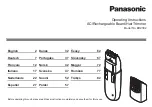
28
12. Technical data
Rated voltage ................................................................ 20 V/DC
Suitable rechargeable batteries (not included) ..............TOOLCRAFT 20 V/2.0 Ah (item no. 1881809)
TOOLCRAFT 20 V/4.0 Ah (item no. 1881810)
TOOLCRAFT 20 V/5.0 Ah (item no. 2331500)
Suitable charger (not included) ......................................TOOLCRAFT 20 V/2.3 A (item no. 1881811)
TOOLCRAFT 20 V/5.0 A (item no. 1881812)
TOOLCRAFT 20 V/ 2x 4.5 A (item no. 2388640)
Cuts/min ........................................................................1300
Cutting length ................................................................410 mm
Tooth spacing / max. cutting diameter ...........................18 mm
Weight ...........................................................................1.99 kg
Sound pressure level L
PA (according to EN 62841)
........................84.4 dB(A)
Sound power level L
WA (according to EN 62841)
............................92.5 dB(A)
Standard deviation K .....................................................3 dB (A)
Vibration level (in accordance with EN 62841) ..............1.27 m/s² (bow handle)
1.01 m/s² (handle)
Uncertainty K .................................................................1.5 m/s²
Dimensions (L x W x H)
.................................................89 x 19 x 20 cm
Operating/storage conditions .........................................
+5 to +40 °C / <85 % relative humidity
Attention!
The noise level of the appliance may exceed 80 dB(A). Wear suitable ear defenders to prevent hearing
damage.
The vibration emission value stated in this manual was obtained using a standardised EN 62841 test
procedure. The result can be used to compare vibration levels of different electrical tools. It can also be
used to obtain a preliminary estimate of your exposure to vibrations.
The specified value indicates the vibration level when the tool is used for its intended purpose. The actual
vibration level may differ from the specified value if the tool is used for other purposes, if other tools are
used, or if the tool has not been serviced properly. These factors can considerably increase your exposure.
For an accurate estimate of your exposure, account for the times when the appliance is switched off or not
in use. These factors can considerably reduce your exposure.
Take additional safety measures to protect the user against the effects of vibration, e.g.: Maintenance of
electric tool and insertion tools, keeping your hands warm, organisation of work processes.
















































